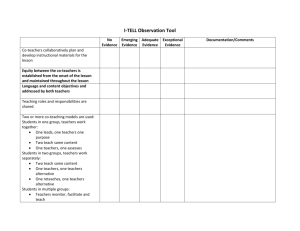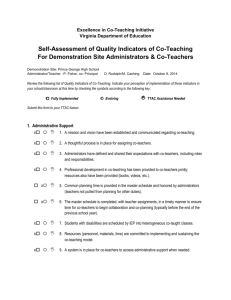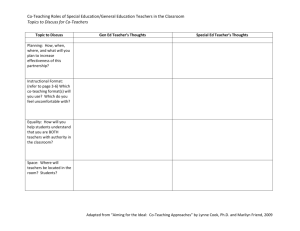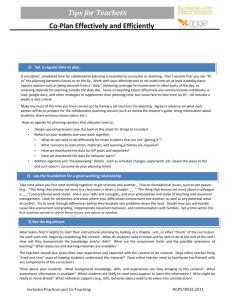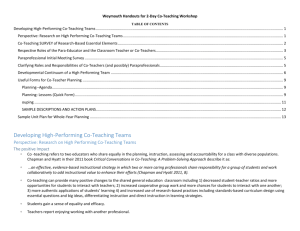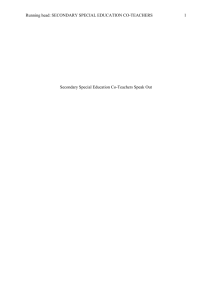Know thy neighbor outline-3 - DPICo
advertisement
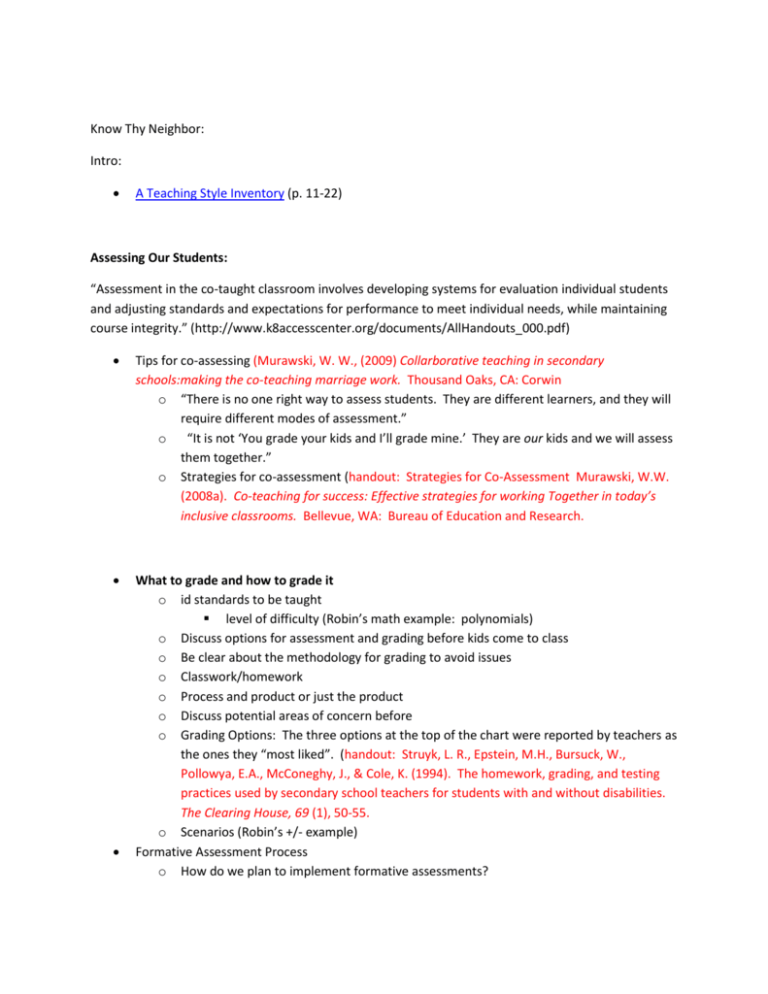
Know Thy Neighbor: Intro: A Teaching Style Inventory (p. 11-22) Assessing Our Students: “Assessment in the co-taught classroom involves developing systems for evaluation individual students and adjusting standards and expectations for performance to meet individual needs, while maintaining course integrity.” (http://www.k8accesscenter.org/documents/AllHandouts_000.pdf) Tips for co-assessing (Murawski, W. W., (2009) Collarborative teaching in secondary schools:making the co-teaching marriage work. Thousand Oaks, CA: Corwin o “There is no one right way to assess students. They are different learners, and they will require different modes of assessment.” o “It is not ‘You grade your kids and I’ll grade mine.’ They are our kids and we will assess them together.” o Strategies for co-assessment (handout: Strategies for Co-Assessment Murawski, W.W. (2008a). Co-teaching for success: Effective strategies for working Together in today’s inclusive classrooms. Bellevue, WA: Bureau of Education and Research. What to grade and how to grade it o id standards to be taught level of difficulty (Robin’s math example: polynomials) o Discuss options for assessment and grading before kids come to class o Be clear about the methodology for grading to avoid issues o Classwork/homework o Process and product or just the product o Discuss potential areas of concern before o Grading Options: The three options at the top of the chart were reported by teachers as the ones they “most liked”. (handout: Struyk, L. R., Epstein, M.H., Bursuck, W., Pollowya, E.A., McConeghy, J., & Cole, K. (1994). The homework, grading, and testing practices used by secondary school teachers for students with and without disabilities. The Clearing House, 69 (1), 50-55. o Scenarios (Robin’s +/- example) Formative Assessment Process o How do we plan to implement formative assessments? o Consider formative assessments during instructional planning for ongoing data collection Summative Assessments Other considerations o Local/district policies/IEP o Subject matter/concepts o Activities Classroom Management and Behavior Intervention Objective: Describe four considerations co-teachers must discuss related to classroom management and behavior intervention. Quotes: “Teachers should focus more on developing the behavior they want developed than on eliminating the ones they want eliminated.” (Tom Lovitt) “It is better to deal with prevention that damage control.” (Judy Wood) Co-teachers must collaborate on the planning of classroom management and behavior interventions based on student needs, curriculum content, and teacher styles. Activity: Write down your assumptions and beliefs about student behavior in the classroom. Compare your list with your co-teacher’s list and discuss. Co-teachers should begin with a discussion of basic beliefs and assumptions about students. o Do you agree on a learning pyramid? (See Handout A: Learning Pyramid) o Do your basic assumptions about student behavior match? All children can learn. All children belong. All children have gifts and strengths. All behavior is communication. Teaming is essential. School staff, families, and others are critical members of the team. o How do teacher behaviors impact student behaviors? (See Handout B: Teacher Behavior) Co-teachers should determine the components of the classroom management system to prevent inappropriate student behavior and promote learning within the school environment. o What exists in the school environment that promotes positive behaviors? (See Handout C: Continuum and Components) o What will co-teachers develop in the classroom to teach positive behaviors and prevent inappropriate behaviors?(See Handout D: Preventive Planning Tips) Individual students may present with challenging behaviors even with a classroom management system. Examples may include: o Difficulty establishing and maintaining relationships with peers and adults o Not trusting others o Demonstrating poor self image o Exhibiting emotional and social immaturity o Problem understanding cause and effect o Seeking excessive attention o Difficulty dealing with authority o Bullying others How will the co-teachers determine the functions of the student’s behaviors? (See Handout E: Functions of Student Behaviors) o Attention Seeking o Sensory Needs o Avoidance o Failure o Confusion o Anxiety o Boredom o Anger When the function is determined how will the co-teachers match interventions to the student’s behaviors?(See Handout F: Interventions for Misbehaviors) o Planned ignoring o Signal interference o Proximity control o Defusing tension through humor o Support for routing o Interest boosting o Removing distracting objects o Antiseptic bouncing What other considerations should be made by the co-teachers? o Does the student have an individual behavior plan? o Can we handle the situation or need help? o Is there potential danger to others of the student? o Is help available? o Can I keep from getting angry? o Is my appearance going to interfere with my ability to respond? o Can we get others to a safe exit if necessary? o Does the student have a history of physical aggression? o Is there anything other than physical intervention that will resolve the crisis? o How will the co-teachers mediate if there is a disagreement about the situation? o Will you intervene if the other teacher is having difficulty handling the situation? Activity: Prioritize at least four considerations that you will make for classroom and behavior management. I suggest removing this bullet. Examples of considerations should include: o o o o o o o o o o o o Classroom rules and processes Consequences and rewards Routines Visual representation of classroom practices Noise level expectations Activity level and breaks Conflict resolution Disruptive behaviors Relationships Lesson presentation Roles/responsibilities (i.e. who contacts parents about behavior/grades) Process for disagreements with each other Teacher Absences/Substitutes Have you thought about the role of a substitute in co-teaching?(p. 17) Substitutes - Louisiana Co-teaching Guide (p. 18) What to do when one or both teachers are absent o A substitute(s) should still be obtained o Substitute folder maintained with class procedures and daily lessons o Confidentiality o Local policies for assignment of substitute Physical Learning Environment Have you thought about the role of a substitute in co-teaching? (p. 17) Substitutes - Louisiana Co-teaching Guide (p. 18) K-8 Assessment Center Facilitate instruction Ensure smooth delivery of instruction Arranged to accommodate co-teaching approach used Clearly delineated areas/purposes defined Instructional focus for walls and bulletin boards ALL children integrated into seating arrangement (not separated EC/Gen ed) Clear classroom routines Both teacher’s names printed on material and outside of room Students work in cooperative grouping assignments Both teachers control spaces; space is jointly owned
